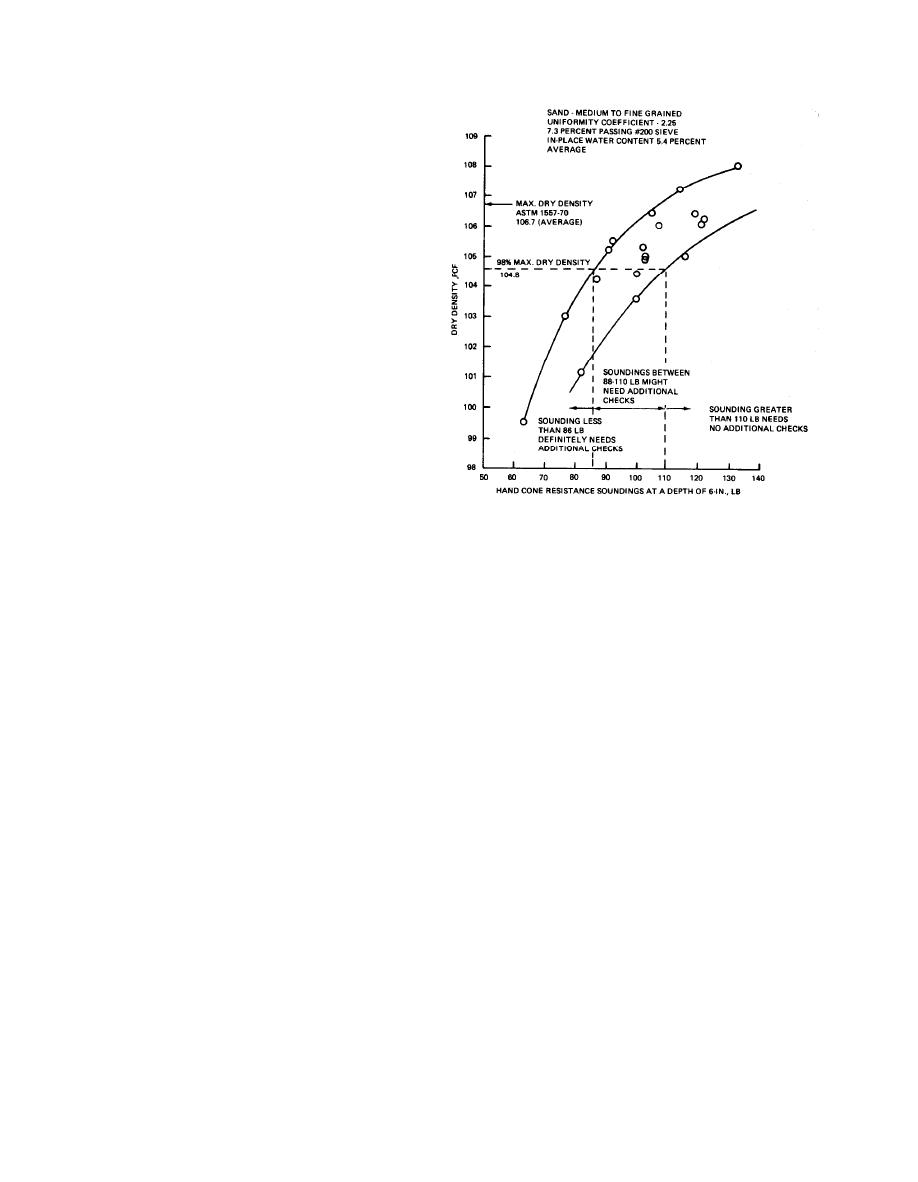
TM 5-818-4/AFM 88-5, Chap. 5
(2) Hand cone penetrometer. The hand cone pene-
to suspect adequate compaction has or has not been
trometer offers a rapid means of checking density re-
achieved.
quirement of some compacted backfills. The process
involves the correlation of penetration resistance with
known in-place densities as determined by either the
sand-cone or the rubber-balloon method.
(a) Cone penetration resistance is a measure-
ment of soil bearing capacity. Since bearing capacity is
dependent on shear strength and thus density, the
hand cone penetrometer is an indirect measurement of
density. Because shear strength is a function of any
pore air and pore water pressures that may be gener-
ated by a shearing action of soils containing pore wa-
ter, the method is applicable only to free-draining
materials where pore pressures are dissipated as fast
as they are generated. Penetration resistance can also
be drastically influenced by the obstruction of gravel-
size particles. Therefore, the method is applicable only
to sands with 100 percent passing the U.S. Standard
No. 4 sieve (4.76 mm) and no more than 15 percent
passing the U.S. Standard No. 200 sieve (0.074 mm).
(b) A plot of hand-cone sounding resistance ver-
sus depth of sounding will result in an approximate
linear relationship for homogenous materials of rela-
tively constant density for depths of sounding ranging
Figure B-7. Correlation between dry density and hand cone resist-
from approximately 2 inches to 20 inches depending
ance at a depth of 6 inches below the surface.
on the geometry and size of the cone point and mate-
(c) The correlation between sounding resistance
rial type. Correlations may be made between known
and known in-place dry densities (fig. B-7) is made di-
in-place densities and either the angle of inclination
rectly without knowing water content at each sound-
between sounding resistance and depth of penetration
ing location. Although sounding resistances are af-
or the sounding resistance at a given depth. The range
fected by water content for the dry, moist, and 1 to 2
of known in-place density must be sufficient to estab-
percentage points above optimum state, the range of
lish a trend between sounding resistance and density.
possible water content in the moist state does not sig-
Correlations between density and sounding resistance
nificantly affect sounding resistance.
at a given depth is the simplest correlation since the
(d) The hand cone penetrometer is ideally suited
angle of inclination does not have to be computed.
for use in confined zones where sand is used as backfill
Figure B-7 shows a case example of a correlation be-
and where rapid control aids are needed to determine
tween dry density and sounding resistance measured
if adequate compaction has been achieved. With a lit-
at 6 inches below the surface. Contract specification
tle practice, a hand-cone sounding can be -made in less
required a minimum acceptable dry density of 104.7
than 1 minute.
pounds per cubic foot (98 percent of the maximum dry
density according to the compaction method described
d. Possible sources of errors. Since the decision to
in ASTM D 1557). Figure B-7 also indicates that all
accept or reject a particular part of a backfill is primar-
soundings with resistances of 110 pounds or more cor-
ily dependent upon the results of in-place density con-
responded to densities greater than 104.6 pounds per
trol tests, it is important for the inspector to be famil-
cubic foot. Therefore, no additional standard density
iar with the possible sources of errors that might cause
checks are needed beyond the routine tests. When all
an inaccurate test result. Some of the more likely
soundings with resistance of 86 pounds and below cor-
sources of errors for the sand-cone, rubber-balloon,
respond to densities below 104.6 pounds per cubic
and nuclear moisture-density methods are discussed
foot, it is evident that sufficient compaction has not
below. All tests that are suspected to be in error must
been achieved and additional standard density checks
be repeated.
are definitely needed for an acceptance or rejection
(1) Sand-cone method. The major sources of possi-
decision. Sounding with resistances between 86 and
ble error are as follows:
110 pounds may or may not need additional density
(a) The sand-cone method relates the bulk den-
checks depending on whether the inspector has reason
sity of a standard sand to the known weight of the
B- 10



 Previous Page
Previous Page
